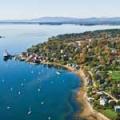Salmon, Shrimp, Whale Pods, and a Chowder Race
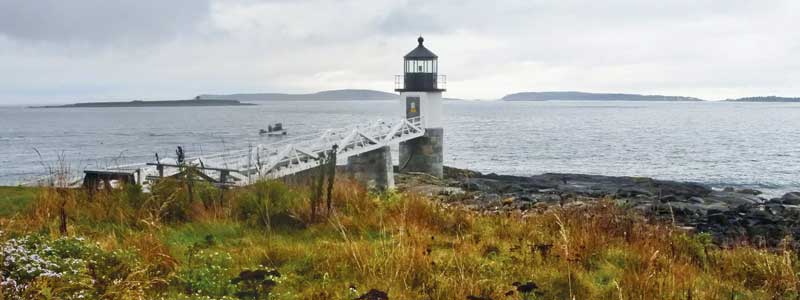 Marshall Point Lighthouse in Port Clyde is one of the many beacons damaged by the January, 2024 storms. Photo by Sean Graves
Marshall Point Lighthouse in Port Clyde is one of the many beacons damaged by the January, 2024 storms. Photo by Sean Graves
Lighthouses on the edge
Maine’s iconic lighthouses, built to protect and guide mariners, are at risk from rising seas, prompting World Monuments Watch to included 66 of the historic structures on its 2025 list of 25 threatened World Heritage sites.
The international organization cited warming in the Gulf of Maine as a major threat. “Purposefully built on islands and low-lying peninsulas, these light stations are extremely vulnerable to rising sea levels and storm surge,” it noted.
Those threats were demonstrated in 2024 when at least 24 lighthouses were heavily damaged in winter storms.
The state’s oldest lighthouse, the Portland Head Light, lit its beacon for the first time in 1791, heralding the construction of 68 other lighthouses through 1910. Dotting the length of the rugged coastline, these structures have provided critical functions in trade and transportation for hundreds of years, promoting the region’s industrial growth and prosperity, according to the international nonprofit.
Today, 66 of Maine’s historic light stations remain standing, 57 of which continue to guide sailors, although ownership has been transferred to local and state government agencies, nonprofit organizations, and private individuals.
Salmon company cans plans
The U.S. subsidiary of a Norwegian company that had hoped to build a massive land-based salmon farm in Belfast, Maine, has decided not to pursue the project.
Nordic Aquafarms said it has spent millions planning the project but was stymied by a series of legal challenges from opponents, including local residents and environmental groups. The final straw, according to news articles in various Maine publications, was the decision by the Belfast City council to withdraw approval for an eminent domain taking of land the company required for outfall pipes into Penobscot Bay.
The company originally proposed a $500 million plant in Belfast with indoor tanks capable of annually producing 30,000 metric tons of Atlantic salmon. Some of the opponents are now suing Nordic Aquafarms for damages.
Meanwhile, a second Maine salmon company faces a legal challenge. The Boston-based Conservation Law Foundation filed suit in January against Cooke Aquaculture, which grows millions of salmon in cages at 13 sites along the downeast Maine coast. Calling the huge cages “sewage pipes to the marine environment,” the environmental group argues the discharge from the cages violates the Clean Water Act. To comply with the law, Cooke will need to hire more employees and experts to increase its monitoring and inspections, properly maintain and clean its equipment, and mitigate the impact on the environment, according to CLF.
The company issued a press release strongly denying the allegations. Saying its Maine operations are heavily regulated, the company also noted it employs 230 people in the state and recently celebrated its 20th anniversary of aquaculture operations in Maine.
Maine’s last seafood cannery closes
It’s the end of an era.
Sea Watch International, which sells cans of clam juice, chowder, and chopped clams, along with other seafood products under the name Bar Harbor Foods, closed its plant in Whiting on Holmes Bay in Washington County last December after more than a century of operations in Maine. About 20 people worked at the cannery at the time, according to reports.
The original company in Maine was founded in 1917 by Willard Look as the East Machias Canning Co. and was later known as the A.M. Look Canning Co., according to the Quoddy Tides, which noted that Look developed the process for canning crab and lobster meat.
The business was the oldest, and last, seafood cannery in a state that once boasted as many as 50 canneries, most of them packing sardines. Maine’s last sardine cannery, which was located in Prospect Harbor, closed in 2010.
Sea Watch International planned to move production to its Milford, Delaware, facility. General Manager Mike Sansing said the company would maintain an office in Whiting but declined to comment on plans for the shuttered plant, according to a Bangor Daily News story.
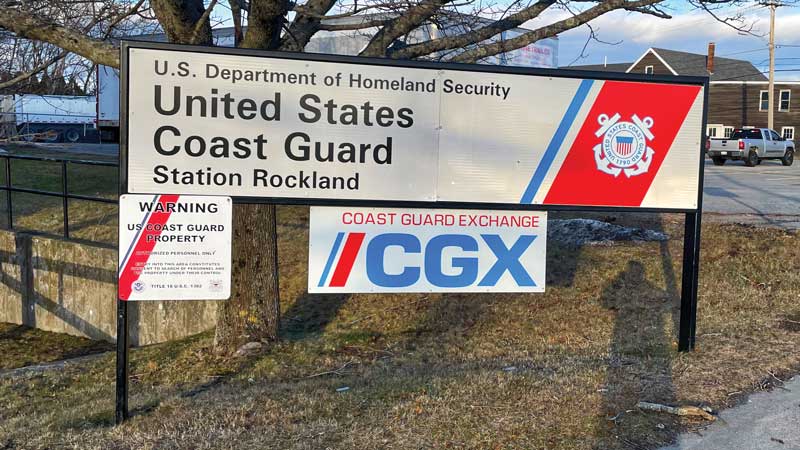 Rockland’s Coast Guard base is due for $40.7 million in pier and boathouse repairs. Photo by Ted Ruegg
Rockland’s Coast Guard base is due for $40.7 million in pier and boathouse repairs. Photo by Ted Ruegg
Ferry dispute
Residents of Maine islands served by the Maine State Ferry Service and Department of Transportation administrators have been tussling over a state proposal to berth ferries on the mainland overnight, rather than on the islands. Ferries have stayed overnight on the islands for decades, where they have been available to transport folks needing emergency medical care to the mainland. Islanders would like to see that continue, but DOT officials have argued that berthing ferries on the mainland could help the agency recruit new ferry workers, filling staffing gaps that have led to trip cancellations. Currently ferry workers are housed on the islands overnight during their work week. The ferry lines in question include those serving islands off Rockland and Mount Desert Island.
DOT officials have said that if the state changes where the ferries berth, separate emergency vessels would be provided for medical transport from the islands at night. Island officials have argued their communities could incur other costs if the shift happens, according to a news article in the Bangor Daily News. Maine Department of Transportation Commissioner Bruce van Note said the agency is leaning toward making the change within two years, per the BDN.
Funding for storm repairs
Up and down the coast, efforts continue to repair piers and other marine facilities damaged in winter storms in 2024, including Coast Guard bases.
Disaster Relief legislation signed into law last year included $42 million for repairs to Coast Guard facilities in Rockland, Southwest Harbor, and Portland. The funding included $40.7 million to repair the pier and boathouse in Rockland, which have been in need of renovations, but have significantly worsened as a result of recent storms; $880,000 in Southwest Harbor to replace dolphin piles, short ties, lighting, and fender systems, and piles on the pier, as well as to repair water damage to the command and boat maintenance building; and $502,000 in Portland to repair the pier and survey for future dredging.
Experimental shrimp fishery
Northern shrimp, once a common catch along the coast, have been off limits to fishermen in Maine for 11 years because of a steep drop in the population of the tasty small crustaceans. The Atlantic States Marine Fisheries Commission has extended the ban through 2025. But a lucky group of fishermen were offered the chance to drop nets for the shrimp this past February and March as part of what the Maine Department of Marine Resources called a “Winter Sampling Research Program” designed to gauge the health of the species, technically known as Pandalus borealis.
The limited program called for allowing shrimpers to catch and sell up to 58,400 pounds, subject to a number of requirements including that the fishermen self-fund their trips. DMR said it would issue up to seven permits for the special program.
Before the moratorium, which began in 2014, fishermen regularly landed more than 10 million pounds in a season, according to an article in the Bangor Daily News. According to Corrin Flora, the DMR employee overseeing the Maine program, more than 40 fishermen applied for the special permits. She told the BDN that fishermen willing to participate were taking a chance because there was no guarantee that they would find any shrimp and there was no money available to recoup any losses.
A new take on a golden oldie
The folks at Brooklin Boat Yard took on an interesting project last year when they partnered with the Northwest School of Wooden Boatbuilding on a project to design a modern version of a classic boat.
Sean Koomen, who had worked at BBY, but is now lead instructor of the boatbuilding program at the school in Port Hadlock, Washington, asked BBY to create a design that would capture the essence of a traditional pilot cutter but with modern performance and construction. The modern boat is to be built side-by-side with a 26-foot full-keel cutter designed by West Coast designer Jim Franken, which will be built in the traditional plank-on-frame manner.
BBY’s design team came up with plans for a light and fast daysailer. Her relatively narrow beam, lightweight hull, and high ballast ratio will make her easily driven, so a massive rig and crew weight on the rail won’t be necessary to sail fast. The balanced hull lines will make her well-mannered, but with enough reserve righting moment and planing area aft that she will have plenty of “get up and go,” according to an account from BBY. An electric pod drive will provide auxiliary power. Down below, accommodations will be limited to sitting headroom and full-length settee/berths port and starboard—just enough for camping.
Maine lakes see warming trend
Maine is home to almost 6,000 lakes and ponds, with some of the cleanest, clearest water in the country. But many are under threat from climate change as their water temperatures are rising at a record pace, according to a recent story on Maine Public Radio.
The news story noted that average surface water temperatures in almost 100 Maine lakes rose 5.5 degrees Fahrenheit between 1980 and 2020, according to long-term monitoring by the Maine Department of Environmental Protection. That’s faster than the annual air temperature increase and outpaces changes in the Gulf of Maine, one of the fastest warming bodies of water on the planet.
The trend means less ice in the winter, more algae blooms and aquatic plants clogging lake water, and lower water quality, according to the report.
Kelp forest in decline
Lakes are not the only places affected by warming trends. A team of scientists led by Douglas Rasher, a senior research scientist at Bigelow Laboratory, recently performed the first in-depth census of Maine’s kelp forests in almost 20 years. Their findings show the widespread collapse of forests along the southern coast but provide new evidence for the surprising resilience of kelp forests in northern Maine, even as warming drives slow but significant declines there, according to a press release from Bigelow Lab.
“I was floored by how dramatically the seaweed communities had changed and how much warmer coastal waters had become,” said Thew Suskiewicz, a former postdoctoral researcher at Bigelow Laboratory and the study’s first author. “The more we sampled for this project, the more apparent those changes were and, sadly, I anticipate this is only the beginning.”
The researchers found that temperatures have become inhospitable, in both the spring and summer, in the southern reaches of the Gulf of Maine where kelp forests have collapsed and been replaced by small filamentous red algae, which form a thick carpet of “turf” on the seafloor.
But they also found that while forests along Maine’s northern coast are also slowly declining, they remain widespread and continue to provide key ecosystem services. The researchers suggest that these regional differences are due to the different ocean currents that run through the Gulf of Maine.
Right whale pod
A group of at least 90 endangered right whales was spotted in January, 2025, swimming near Jeffreys Ledge in the Gulf of Maine. The sighting prompted strongly worded emails to fishermen from Maine Department of Marine Resources Commissioner Patrick Keliher. He urged fishermen to move their gear from the area, writing “The ramifications of another entanglement in Maine gear could be devastating to your fishery.”
A slow zone for boaters of no more than 10 knots was also implemented.
Lobstermen in Maine have been fighting federal proposals designed to protect right whales, arguing the rules are based on incomplete data and, if implemented, will threaten their business.
The group of right whales gathered at Jeffreys Ledge—a long, underwater ridge that attracts marine life—is unusually large and represents almost a quarter of the remaining global population, according to stories in the Portland Press Herald.
A “large amount” of fixed fishing gear was also spotted in the area, according to the National Oceanographic and Atmospheric Administration.
“I cannot predict what will happen if Maine gear entangles a right whale, however it is possible that resulting federal regulatory restrictions on the Maine lobster fishery could be catastrophic—including extensive additional prohibitions on the use of traditional gear,” Keliher said in his email.
Officials directly linked the death of a whale last fall to a Maine lobsterman’s gear for the first time in recent years.
Chowder Cup Race returns
Plans are underway to hold the annual Chowder Cup race in Muscongus Bay on August 2. The sailboat race is open to anything that floats with a sail. It was started in the 1930s by the now defunct Royal Friendship Yacht Club. After several decades of dormancy, the race was reestablished in 1979.This year’s race will be the 46th in the “modern era.” The 8.4-mile course starts and finishes at the mouth of Friendship Harbor. There will be three classes—18 feet and under, 19 to 27 feet, and 28 feet and over.The essence of the Chowder Cup is captured in its motto, “Pure Sailing, No Protests, No Excuses.” There is no cost to enter, and there is a potluck dinner afterward for all sailors and supporters.Contact the Chowder Cup Committee for info at Friendshipchowdercup@gmail.com.
Remembering Tony Correa (July 1, 1941 – January 10, 2025)
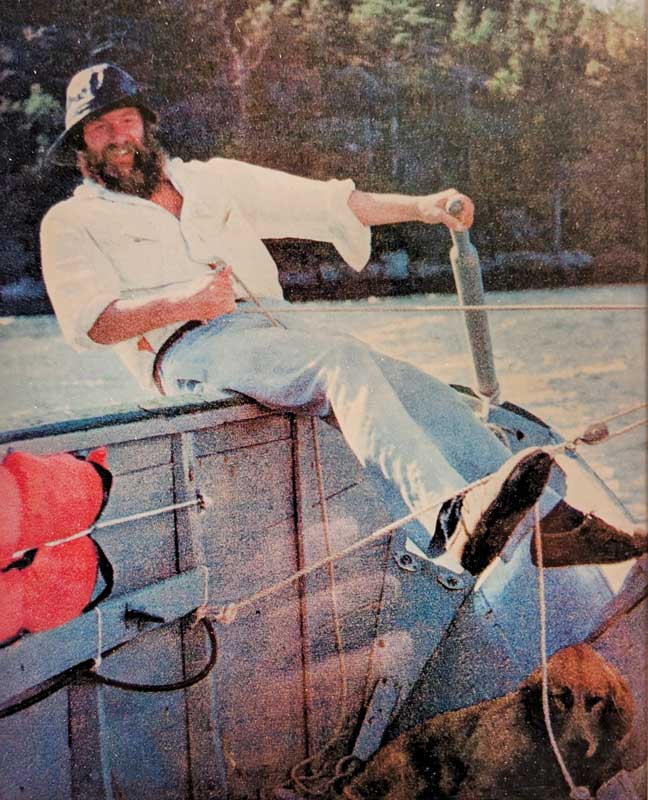 Tony Correa sailing the first of many boats named Noeta. Photo courtesy Andy Correa
The boating business was a different world back in the late 1960s and 1970s. At the boat shows you could feel the energy, with many of the exhibitors representing new businesses born out of their founder’s passion for boats. Sailors became boatbuilders who then became business owners. It was exciting to be part of it. In 1969, Tony Correa took his love of boats onto a slightly different tack. He made and sold beautiful gold jewelry of boats and other nautical items and named his Wiscasset-based company A.G.A. Correa and Son.
Tony Correa sailing the first of many boats named Noeta. Photo courtesy Andy Correa
The boating business was a different world back in the late 1960s and 1970s. At the boat shows you could feel the energy, with many of the exhibitors representing new businesses born out of their founder’s passion for boats. Sailors became boatbuilders who then became business owners. It was exciting to be part of it. In 1969, Tony Correa took his love of boats onto a slightly different tack. He made and sold beautiful gold jewelry of boats and other nautical items and named his Wiscasset-based company A.G.A. Correa and Son.
He was one of my first contacts when I worked my first boat show, the 1976 Newport Sailboat Show. He was hard to miss, bigger than life and louder than most. His booth was most always crowded, if not with customers, with his many friends in the industry, especially those of us from Maine. He became a friend, as is his son, Andy, who now runs the business, and is one of the most ardent supporters of this magazine. A very grateful tip of the hat to him for that.
Tony also was a passionate sailboat racer with his beautiful Aage Nielsen yawl Noeta (standing for No Estimated Time of Arrival) on the classic yacht circuit. I bought my Bill Tripp-designed wooden boat, Fiery Jubilee, to race against him. We had some classic battles—he won some, we won some, but they were always epic.
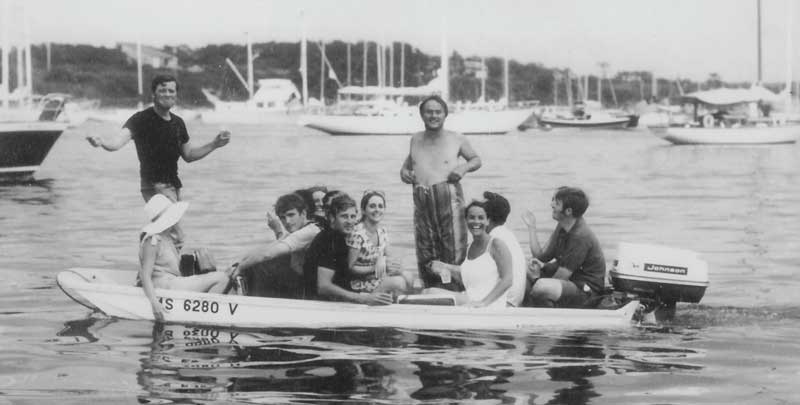 The Correa family owned one of the first Whalers, and Tony proved more than once that the boat is nearly unsinkable. Photo courtesy Tony Correa
The Correa family owned one of the first Whalers, and Tony proved more than once that the boat is nearly unsinkable. Photo courtesy Tony Correa
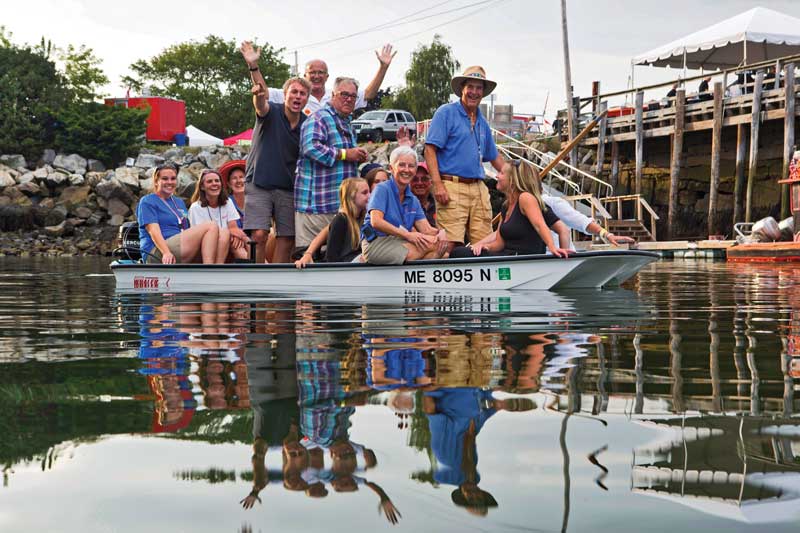 Photo by Billy Black
Photo by Billy Black
Tony was a terrific storyteller, and his story of loading about a dozen of his teenage friends into his family’s 13-foot Boston Whaler in the Sixties was hilarious and led to the re-enactment of this stunt at the 2016 Maine Boat & Home Show (photo above). What a hoot! Laughter and boats went together for Tony Correa.
He will be missed.
—John K. Hanson Jr., Publisher Emeritus
Record home sale
Waterfront homes in Maine continue to attract big money. An ocean-front home in Kennebunkport sold for a record-breaking $12 million just 90 minutes after the listing went live in January, 2025, according to a story in the Portland Press Herald. Listed with Legacy Properties Sotheby’s International Realty, the sale was the highest sale of all time in Kennebunkport, and the No. 1 sale in Maine since 2022, according to a release from the real estate firm.
Built in 1969, the roughly 5,000-square-foot property includes five bedrooms and three baths, with walls of windows facing the ocean and overlooking the Bush family’s Walkers Point compound, according to the listing. The 1.1-acre property includes 275 feet of bold waterfront.
The home was bought by a Chicago-based industrialist with significant ties to Maine, the Portland paper reported. The listing broker declined to tell the newspaper the name of the buyer but did say the client did not tour the property until a couple of weeks after the sale.
Oops
A keen-eyed reader wrote in to point out a gaff we all missed in a report in the last On the Town Dock about a new buoy that marks Drunkard Ledge, near the entrance to the Fox Island Thorofare from West Penobscot Bay. For the record, the ledge is visible at low tide but not at high tide. Obviously.
In marine industry news
Hinckley has a new leader; Rossiter Boats has a new dealer; and the Boothbay Region Maritime Foundation is building a new pier.
Gavin McClintock joined the Hinckley Co. as its new Chief Executive Officer. He previously served as Chief Financial Officer for Safe Harbor Marinas and as founder of the marina group Tidekeeper. Geoff Berger, who has served as CEO, will continue to support the company as a member of the Board of Directors, according to a release from Hinckley.
Ontario-based Rossiter Boats has contracted with Oyster Harbors Marine to represent the Canadian builder inseveral New England states, carrying Rossiter’s five models. The company has sales offices in Falmouth, Marion, Danvers, and Hingham, Massachusetts; Newport, Rhode Island; Essex, Connecticut; and York, Maine.
And in Boothbay, the local Maritime Foundation signed a contract with Fuller Marine to build a new commercial fishing pier and seawall at Carter’s Wharf on Atlantic Avenue, the former site of the Sea Pier. The granite seawall will be raised to meet current FEMA flood zone height requirements. Funds for the $2.1 million project include grants from the state, the Mildred McEvoy Foundation, and other anonymous grants as well as donations from generous individuals. Additional funds are being sought for the remainder of the project, which includes construction of a buying station, fueling station, and marina.
✮
Related Articles
Share this article:
2023 Maine Boat & Home Show

Join Us for the Maine Boat & Home Show!
Art, Artisans, Food, Fun & Boats, Boats, Boats
August 11 - 13, 2023 | On the waterfront, Rockland, Maine
Click here to pre-order your tickets.
Show is produced by Maine Boats, Homes & Harbors magazine.










